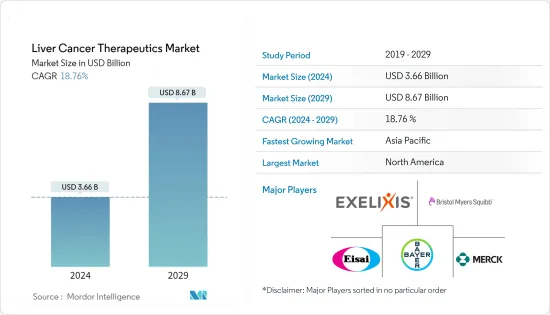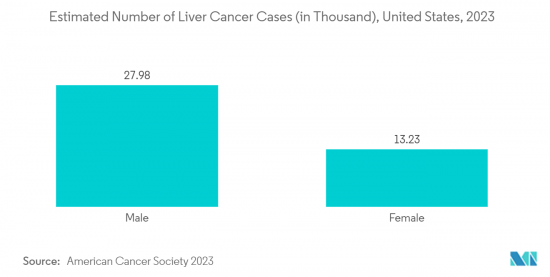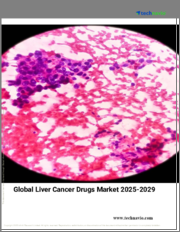
|
시장보고서
상품코드
1403900
세계 간암 치료 시장 - 점유율 분석, 산업 동향, 통계 및 성장 예측(2024-2029년)Liver Cancer Therapeutics - Market Share Analysis, Industry Trends & Statistics, Growth Forecasts 2024 - 2029 |
||||||
간암 치료 시장 규모는 2024년 36억 6,000만 달러로 추정되며, 2029년 86억 7,000만 달러에 이를 것으로 예측되며, 예측 기간(2024-2029년)의 CAGR은 18.76%로 성장할 전망입니다.

주요 하이라이트
- COVID-19의 출현은 SARS-CoV-2 바이러스의 높은 감염률로 인한 의료 자원에 대한 높은 부담으로 인해 COVID-19 이외의 환자에게도 큰 영향을 미쳤습니다. COVID-19로 인해 진단과 치료가 지연되거나 일정이 변경되어 간암 환자도 유행의 영향을 받았습니다. 또한 합병증이 있는 사람은 COVID-19에 감염될 위험이 높기 때문에 병원에서는 새로운 사례의 치료나 진단을 위한 환자수가 감소했습니다.
- 예를 들어, 2021년 2월에 PubMed에 발표된 조사 연구에 따르면, 간암 환자의 통상의 치료는 COVID-19 팬데믹의 제1파에 의해 큰 영향을 받아 환자의 스크리닝, 진단, 치료의 알고리즘의 변경이 유행 중 예후에 심각한 부정적인 영향을 미칠 수 있습니다. 그러나 COVID-19의 증례 수가 감소함에 따라 암 치료의 연구개발이 증가하고 간암 치료의 다양한 파이프라인 자산을 도입하기 위한 주요 기업 간의 경쟁이 치열해지고 있기 때문에 간암 치료 시장은 향후 수년간 본격적인 성장력을 획득할 것으로 예상됩니다.
- 시장 성장을 가속하는 주요 요인으로는 간암의 부담 증가, 신규 치료법 개발을 위한 연구개발 투자 증가, 암에 대한 인식을 높이기 위한 정부의 대처 등을 들 수 있습니다.
- Cancer Australia 2022년의 통계에 따르면, 호주는 2022년에 새롭게 2,905건(남성 2,113건, 여성 792건)의 간암이 진단되었습니다. 또한 2022년 호주에서 85세까지 간암으로 진단되는 위험은 103명 중 1명(또는 0.97%)(남성은 70명 중 1명 또는 1.4%, 여성은 195명 중 1명 또는 0.51%)입니다. 따라서 효과적이고 선진적인 간암 치료에 대한 수요는 해마다 증가하고 시장 성장을 가속할 것으로 예상됩니다. 현재의 라이프 스타일 변화로 인해 많은 인구가 간암을 일으키는 특정 위험 요인에 노출되었습니다. 이 위험인자에는 2형 당뇨병, 간염, 대사 이상, 체중 과다, 음주, 흡연 등이 포함되어 예측 기간 중 간암 치료 시장의 성장을 더욱 증대시킬 것으로 예상됩니다.
- 게다가 이 분야에서의 연구활동과 자금 제공 증가는 이들 연구에 의한 긍정적인 결과가 간암의 신규 치료에 대한 길을 열 수 있기 때문에 시장 성장을 더욱 밀어올릴 것으로 예상 합니다. 예를 들어, 2023년 3월, 뉴캐슬 대학의 과학자들은 성인과 소아 간암과의 싸움에 자금을 제공하기 위해 Cancer Research UK로부터 약 600만 파운드(740만 달러)를 받았습니다. 간암 환자는 200만 파운드(240만 달러) 근처의 혜택을 받을 것으로 추정됩니다.
- 또한 다양한 간암 계발 캠페인이 실시되고 있어 환자 교육과 간암 치료의 중요성을 전하는 길이 더욱 열리고 예측 기간 중 시장 성장을 뒷받침할 것으로 기대되고 있습니다. 예를 들어, 2022년 7월, 카타르암 협회(QCS)는 카타르 적신월사와 협력하여 간암에 대한 인식을 높이기 위해 'Protect Yourself' 캠페인을 시작했습니다. 또한 이 캠페인에는 특히 근로자 센터에서의 의식 촉진을 목적으로 하는 워크숍과 연설이 포함되어 있었습니다.
- 따라서 간암과 그 위험인자의 부담이 크고 현재 진행중인 연구개발 활동이 함께 예측기간 중 시장 성장을 밀어올릴 것으로 예상됩니다. 그러나 특정 약제에 따른 부작용, 암 치료의 고비용, 엄격한 규제 시나리오 등의 요인이 예측 기간 중 시장 성장을 저해할 것으로 예상됩니다.
간암 치료 시장 동향
예측 기간 동안 간세포 암 부문이 큰 점유율을 차지할 전망
- 간세포암(HCC)은 간경변 등 만성 간질환을 앓고 있는 사람에게 발생하는 일반적인 간암입니다. HCC는 일반적으로 초기 단계에서 천천히 성장하기 때문에 적절한 치료 옵션으로 조기에 발견되면 치유되는 경우가 많습니다.
- 주요 기업에 의한 전략적 활동 증가, 간암 치료에 관한 인식, HCC 치료에 관한 조사 연구 증가 등의 요인이 예측 기간 동안 동 분야의 성장을 뒷받침할 것으로 예상됩니다.
- 간세포암을 치료하기 위한 다양한 치료법이 등장해, 이 부문은 연구개발에 노출되게 되었습니다. 예를 들어, 2021년 4월에 Nature Journal에 게재된 논문에 따르면, 진행 HCC에 대한 이용가능한 최상의 선택 치료는 아테졸리주맙에 의한 PDL1 차단과 베바시주맙에 의한 VEGF 차단의 병용입니다. 면역요법은 보다 조기 간세포암에서는 국소·국소요법과의 시너지 효과를 기대할 수 있습니다. 이와 같이, HCC에서의 새로운 면역요법의 도입은 예측 기간동안 이 분야의 성장을 뒷받침할 것으로 예상됩니다.
- 또한 주요 기업의 승인과 전략적 활동 증가는 시장 성장을 증진시킬 것으로 예상됩니다. 예를 들어, 2023년 2월, Genoscience Pharma사는 간세포암(HCC)의 치료로서 에즈르핌트로스타트(ezurpimtrostat)의 희소질환용 의약품의 지정을 FDA(미국 식품의약국)에서 받았습니다. 에즐핌트로스타트(GNS561)는 퍼스트 인 클래스, 퍼스트 인 인간의 오토퍼지 억제제이며, 그 항암 활성은 PPT-1 억제와 관련되어 있습니다.
- 또한, 2022년 10월, Innovent Biologics, Inc.의 사이람자(람실맙)는 α-페토프로테인이 400ng/mL 이상으로, 소라페닙에 의한 치료력이 있는 간세포암(HCC, 간암이라고도 불린다) 환자를 대상으로 하는 추가 신약 승인 신청(sNDA)을 중국 국가 의약품 감독 관리국(NMPA)이 승인했습니다. 또한 2022년 3월 혁신과 릴리는 암 영역에서 전략적 파트너십을 확대했습니다.
- 따라서 주요 기업에 의한 연구활동과 전략적 이니셔티브 증가와 제품의 상시에 의해 조사 부문은 예측 기간 동안 큰 성장을 이룰 것으로 예상됩니다.

북미는 예측 기간 동안 큰 시장 점유율을 차지할 것으로 예측
- 북미는 이 지역에서 간암의 이환율 상승, 주요 시장 진출기업의 존재, 간암 치료 개발을 위한 다양한 투자와 자금 조달과 함께 신제품 출시로 조사 시장에서 큰 점유율을 차지할 것으로 예상됩니다. 예를 들어 캐나다암 협회의 2022년 통계에 따르면 캐나다에서는 3,500명의 캐나다인이 간암으로 진단되었습니다.
- 이 지역에서 간암의 상당한 유병률은 시장의 주요 추진력이 될 것으로 예상됩니다. 간암에 대한 인식이 높아지고 그 부담이 증가함에 따라 치료법의 채용과 수요도 급증합니다. 이것은 고려중인 시장에 긍정적인 영향을 미칠 것으로 예상됩니다.
- 예를 들어, 미국 암 협회의 2023년 보고서에 따르면, 미국에서는 2023년에 약 41,210례의 간암과 간내 담관암이 새롭게 진단될 전망이며, 이는 간암 치료 시장에 좋은 영향을 미칠 것으로 예상됩니다. 게다가 간 신규 치료의 개발에 있어서의 연구개발 활동이나 주요 기업에 의한 전략적 활동의 활성화도 시장 성장의 원동력이 될 것으로 예상됩니다.
- 예를 들어, 2021년 3월 Boston Scientific Corporation은 간세포암(HCC) 환자의 치료를 위해 개발된 세라스피어 Y-90 유리 미소구의 FDA 승인을 받았습니다. 마찬가지로, 2022년 1월, 머크는 2회째의 확인 시험에 근거해, 의약품 키트루다의 조건부 간암 치료 승인을 취득했습니다. 키트루다는 아시아에서 간세포암 환자에서 위약보다 사망 위험을 21% 저하시켰습니다.
- 따라서 간암의 이환율 증가와 주요 기업에 의한 전략적 활동의 활성화는 조사 대상 지역에서의 간암 치료 수요를 증가시켜 예측 기간에 걸쳐 시장을 견인하고 있습니다.
간암 치료 산업 개요
간암 치료 시장은 소수의 주요 시장 진출기업의 존재에 의해 통합된 성질을 가지고 있습니다. 주요 시장 진출기업은 간암 치료를 위한 혁신적인 치료법을 가져오기 위해 연구 개발에 주력하고 있습니다. 주요 시장 진출기업은 F. Hoffmann-La Roche Ltd, Bayer AG, Bristol Myers Squibb Company, Eisai, Exelixis Inc. 등입니다.
기타 혜택:
- 엑셀 형식 시장 예측(ME) 시트
- 3개월간의 애널리스트 서포트
목차
제1장 서론
- 조사의 전제조건과 시장의 정의
- 조사 범위
제2장 조사 방법
제3장 주요 요약
제4장 시장 역학
- 시장 개요
- 시장 성장 촉진요인
- 간암의 부담 증가
- 신규 치료법 개발을 위한 R&D 투자 증가
- 암에 대한 인식을 높이기 위한 정부의 대처
- 시장 성장 억제요인
- 특정 약물 요법에 따른 부작용과 암 치료비의 상승
- 엄격한 규제 시나리오
- Porter's Five Forces 분석
- 신규 참가업체의 위협
- 구매자/소비자의 협상력
- 공급기업의 협상력
- 대체품의 위협
- 경쟁 기업간 경쟁 관계의 강도
제5장 시장 세분화(시장 규모-달러)
- 유형별
- 간세포암
- 담관암
- 간아종
- 기타 유형
- 치료법별
- 표적요법
- 방사선요법
- 면역요법
- 화학요법
- 지역별
- 북미
- 미국
- 캐나다
- 멕시코
- 유럽
- 독일
- 영국
- 프랑스
- 이탈리아
- 스페인
- 기타 유럽
- 아시아태평양
- 중국
- 일본
- 인도
- 호주
- 한국
- 기타 아시아태평양
- 중동 및 아프리카
- GCC 국가
- 남아프리카
- 기타 중동 및 아프리카
- 남미
- 브라질
- 아르헨티나
- 기타 남미
- 북미
제6장 경쟁 구도
- 기업 프로파일
- F. Hoffmann-La Roche Ltd
- Bayer AG
- Bristol Myers Squibb Company
- Celsion Corporation
- Eisai Co. Ltd
- Exelixis Inc.
- Eli Lilly and Company
- Merck & Co. Inc.
- Pfizer Inc.
- AbbVie Inc.
- Amgen Inc.
- AstraZeneca PLC
- Johnson & Johnson
- Sanofi SA
- Novartis AG
제7장 시장 기회와 앞으로의 동향
JHS 24.01.23
The Liver Cancer Therapeutics Market size is estimated at USD 3.66 billion in 2024, and is expected to reach USD 8.67 billion by 2029, growing at a CAGR of 18.76% during the forecast period (2024-2029).
Key Highlights
- The emergence of COVID-19 had a major impact on patients other than COVID-19 due to the high burden on healthcare resources owing to the high infection rate of the SARS-CoV-2 virus. People with liver cancer were also impacted by the pandemic, as due to COVID-19, there was a delay or rescheduling of the diagnostics and treatment procedures. Also, people with comorbidity were at higher risk of contracting COVID-19, which led to a decline in the patient pool in hospitals for treatment and diagnostics of new cases.
- For instance, according to a research study published in February 2021 in PubMed, the normal treatment of patients with liver cancer was significantly impacted by the first wave of the COVID-19 epidemic, and changes to the algorithms for screening, diagnosing, and treating patients may have materially harmed their prognosis during the pandemic. However, as the number of COVID-19 cases decreases, the liver cancer therapeutics market is expected to gain its full growth potential in the coming years due to the increase in research and development for cancer therapeutics and intense competition between the key players to introduce various pipeline assets for liver cancer therapies.
- The major factors driving the market growth include the rising burden of liver cancer, increasing research and development investments for the development of novel therapies, and government initiatives to increase cancer awareness.
- According to the Cancer Australia 2022 statistics, 2,905 new cases of liver cancer were diagnosed in Australia (2,113 males and 792 females) in 2022. Also, a person had a 1 in 103 (or 0.97%) risk of being diagnosed with liver cancer by the age of 85 (1 in 70 or 1.4% for males and 1 in 195 or 0.51% for females) in 2022 in Australia. Hence, the demand for effective and advanced liver cancer therapeutics is expected to increase over the years, fuelling market growth. The change in the current lifestyle led to the exposure of a large population to certain risk factors that contribute to liver cancer. The risk factors include type 2 diabetes, hepatitis, metabolic disorders, excess body weight, alcohol consumption, and smoking, which are further expected to augment the liver cancer therapeutics market's growth over the forecast period.
- Moreover, the increasing research activities and funding in the area are further expected to boost the market's growth as a positive outcome from these studies may pave the way for a novel treatment for liver cancer. For instance, in March 2023, New Castle University Scientists received nearly GBP 6 million (USD 7.4 million) from Cancer Research UK to fund their fight against the disease in adults and children. Patients with liver cancer are estimated to benefit from nearly GBP 2 million (USD 2.4 million).
- Furthermore, various liver cancer awareness campaigns are being conducted, which further paves the path for patient education and the importance of liver cancer therapies, which is expected to fuel the market growth over the forecast period. For instance, in July 2022, Qatar Cancer Society (QCS), in cooperation with Qatar Red Crescent, launched the 'Protect Yourself' campaign to raise awareness of liver cancer. Also, the campaign contained several workshops and speeches aimed at promoting awareness, particularly in workers' centers.
- Therefore, the high burden of liver cancer and its risk factors, coupled with ongoing research and development activities, is expected to boost the market's growth over the forecast period. However, factors such as side effects associated with certain medications, the high cost of cancer therapies, and stringent regulatory scenarios are expected to impede market growth over the forecast period.
Liver Cancer Therapeutics Market Trends
Hepatocellular Carcinoma Segment is Expected to Occupy a Significant Share Over the Forecast Period
- Hepatocellular carcinoma (HCC) is a common form of liver cancer that occurs in people suffering from chronic liver diseases like cirrhosis. Since HCC usually grows slowly in its early stages, it can often be cured if discovered early enough with proper treatment options.
- Factors such as an increase in strategic activities by the key players, awareness relating to liver cancer treatments, and a rise in research studies related to the treatments for HCC are expected to bolster segment growth over the forecast period.
- Various therapies have emerged for treating HCC, which made the segment more exposed to research and development. For instance, as per the article published in April 2021 in Nature Journal, the best available first-line treatment for advanced HCC is a combination of PDL1 blockade with atezolizumab and VEGF blockade with bevacizumab. Immunotherapy is likely to synergize with local and locoregional interventions in earlier stages of HCC. Thus, the introduction of new immunotherapies in HCC is expected to bolster segment growth over the forecast period.
- Furthermore, a rise in approvals and strategic activities by the key players is expected to augment the market growth. For instance, in February 2023, Genoscience Pharma received a Food Drug Administration (FDA) Orphan Drug Designation for ezurpimtrostat to treat hepatocellular carcinoma (HCC). Ezurpimtrostat (GNS561) is a first-in-class, first-in-human autophagy inhibitor whose anticancer activity is linked to PPT-1 inhibition.
- Also, in October 2022, the National Medical Products Administration (NMPA) of China approved the supplemental New Drug Application (sNDA) for CYRAMZA (ramucirumab) by Innovent Biologics, Inc., in patients with hepatocellular carcinoma (HCC, also known as liver cancer), who have an alpha-fetoprotein of more than or equal to 400 ng/mL and have been treated with sorafenib. Also, in March 2022, Innovent and Lilly expanded their strategic partnership in oncology.
- Therefore, due to the increase in research activities and strategic initiatives by the key players coupled with product launches, the studied segment is expected to witness significant growth over the forecast period.

North America is Anticipated to Hold a Significant Market Share Over the Forecast Period
- North America is expected to hold a significant share of the studied market owing to the rising incidence of liver cancer in the region, the presence of key market players, and the launch of novel products coupled with various investments as well as funding for liver cancer therapeutics development. For instance, as per the Canadian Cancer Society 2022 statistics, 3,500 Canadians were diagnosed with liver cancer in Canada.
- The substantial prevalence of liver cancer in the region is anticipated to be the key driving force for the market. As awareness of liver cancer continues to rise and its burden increases, there is a corresponding surge in the adoption and demand for treatment procedures. This is expected to exert a favorable influence on the market under examination.
- For instance, according to the 2023 report of the American Cancer Society, about 41,210 new cases of liver and intrahepatic bile duct cancer are expected to be diagnosed in the United States in 2023, which is expected to have a positive impact on liver cancer therapeutics market. Further, the increasing research and development activities and strategic activities by the key players in the development of novel therapeutics for the liver are also expected to drive market growth.
- For instance, in March 2021, Boston Scientific Corporation received FDA approval for the TheraSphere Y-90 Glass Microspheres, developed for the treatment of patients with hepatocellular carcinoma (HCC). Similarly, in January 2022, Merck received conditional liver cancer treatment approval for its drug Keytruda based on its second confirmatory study. Keytruda slashed the risk of death by 21% over placebo in hepatocellular carcinoma patients in Asia.
- Therefore, the increased incidence of liver cancer and the rise in strategic activities by the key players increase the demand for liver cancer treatment in the studied region, which is driving the market over the forecast period.
Liver Cancer Therapeutics Industry Overview
The liver cancer therapeutics market studied is consolidated in nature owing to the presence of a few major market players. The key market players are focusing on R&D to bring innovative treatments for the treatment of liver cancer. The key market players are F. Hoffmann-La Roche Ltd, Bayer AG, Bristol Myers Squibb Company, Eisai Co. Ltd, and Exelixis Inc., among others.
Additional Benefits:
- The market estimate (ME) sheet in Excel format
- 3 months of analyst support
TABLE OF CONTENTS
1 INTRODUCTION
- 1.1 Study Assumptions and Market Definitions
- 1.2 Scope of the Study
2 RESEARCH METHODOLOGY
3 EXECUTIVE SUMMARY
4 MARKET DYNAMICS
- 4.1 Market Overview
- 4.2 Market Drivers
- 4.2.1 Rising Burden of Liver Cancer
- 4.2.2 Increasing R&D Investments for the Development of Novel Therapies
- 4.2.3 Government Initiatives to Increase the Cancer Awareness
- 4.3 Market Restraints
- 4.3.1 Side Effects Associated with Certain Medications Coupled with High Cost of Cancer Therapies
- 4.3.2 Stringent Regulatory Scenario
- 4.4 Porter's Five Forces Analysis
- 4.4.1 Threat of New Entrants
- 4.4.2 Bargaining Power of Buyers/Consumers
- 4.4.3 Bargaining Power of Suppliers
- 4.4.4 Threat of Substitute Products
- 4.4.5 Intensity of Competitive Rivalry
5 MARKET SEGMENTATION (Market Size by Value - USD)
- 5.1 By Type
- 5.1.1 Hepatocellular Carcinoma
- 5.1.2 Cholangio Carcinoma
- 5.1.3 Hepatoblastoma
- 5.1.4 Other Types
- 5.2 By Therapy
- 5.2.1 Targeted Therapy
- 5.2.2 Radiation Therapy
- 5.2.3 Immunotherapy
- 5.2.4 Chemotherapy
- 5.3 Geography
- 5.3.1 North America
- 5.3.1.1 United States
- 5.3.1.2 Canada
- 5.3.1.3 Mexico
- 5.3.2 Europe
- 5.3.2.1 Germany
- 5.3.2.2 United Kingdom
- 5.3.2.3 France
- 5.3.2.4 Italy
- 5.3.2.5 Spain
- 5.3.2.6 Rest of Europe
- 5.3.3 Asia-Pacific
- 5.3.3.1 China
- 5.3.3.2 Japan
- 5.3.3.3 India
- 5.3.3.4 Australia
- 5.3.3.5 South Korea
- 5.3.3.6 Rest of Asia-Pacific
- 5.3.4 Middle East and Africa
- 5.3.4.1 GCC
- 5.3.4.2 South Africa
- 5.3.4.3 Rest of Middle East and Africa
- 5.3.5 South America
- 5.3.5.1 Brazil
- 5.3.5.2 Argentina
- 5.3.5.3 Rest of South America
- 5.3.1 North America
6 COMPETITIVE LANDSCAPE
- 6.1 Company Profiles
- 6.1.1 F. Hoffmann-La Roche Ltd
- 6.1.2 Bayer AG
- 6.1.3 Bristol Myers Squibb Company
- 6.1.4 Celsion Corporation
- 6.1.5 Eisai Co. Ltd
- 6.1.6 Exelixis Inc.
- 6.1.7 Eli Lilly and Company
- 6.1.8 Merck & Co. Inc.
- 6.1.9 Pfizer Inc.
- 6.1.10 AbbVie Inc.
- 6.1.11 Amgen Inc.
- 6.1.12 AstraZeneca PLC
- 6.1.13 Johnson & Johnson
- 6.1.14 Sanofi SA
- 6.1.15 Novartis AG

















